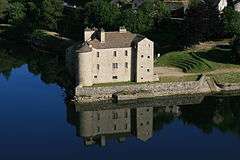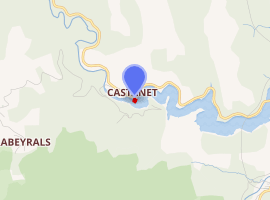Château de Castanet
The castle of Castanet is a French castle built in the 16th century in Pourcharesse near Villefort in Lozère, France.
| Castle of Castanet | |
|---|---|
Château de Castanet | |
 | |

| |
| Website | |
| http://www.villefort-cevennes.com/-Chateau-de-Castanet- |
Overview
The territory of Castanet has its origin of its name (chestnut) in the Occitan language, as Chestnut Trees are the most common tree in the territory.[1] The castle is next to the lake of Villefort, an artificial lake created behind the Villefort's dam, who went bankrupt destroy the castle.
History
The castle was built in 1578 by Jacques Isarn, a noble of Villefort. This family continued to grow in importance until marriage to a descendant with Marie-Suzanne de Varicourt "Marquise de Villefort", nourish and savior of the future King of France Louis XV. This évent led the family to move to Versailles.
It was sold in 1760 and after the emigration of the last owner, it will be sold as a national asset during the French Revolution. After that, the castle belonged to farmers.
In 1962, the national company "Electricité de France" decided to build a dam in the valley. So it expropriated the last owners and planned to destroy the castle but the villagers revolted and entered the castle to make an Inventory of Historicals Monuments. In 1964, E.D.F assign the monument to the Community of communes of Villefort. The castle was reinforced to protect it from dangers of the lake.
In 2000, a terrible fire destroyed the castle but after extensive renovation works, it reopened its doors in 2006. It now hosts a permanent exhibition on the history of the region and temporary exhibitions of artists and craftsmen.[2]
References
- "Château de Castanet : Séances, tarifs et réservation de la visite guidée — MesSortiesCulture". www.messortiesculture.com. Retrieved 2019-12-03.
- "Château de Castanet". destination.cevennes-parcnational.fr. 16 September 2019. Retrieved 2019-12-03.
| Wikimedia Commons has media related to Château de Castanet. |
- The information in this article is based on that in its French equivalent.